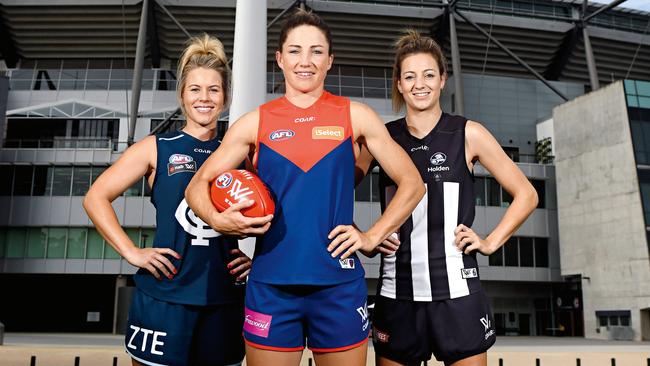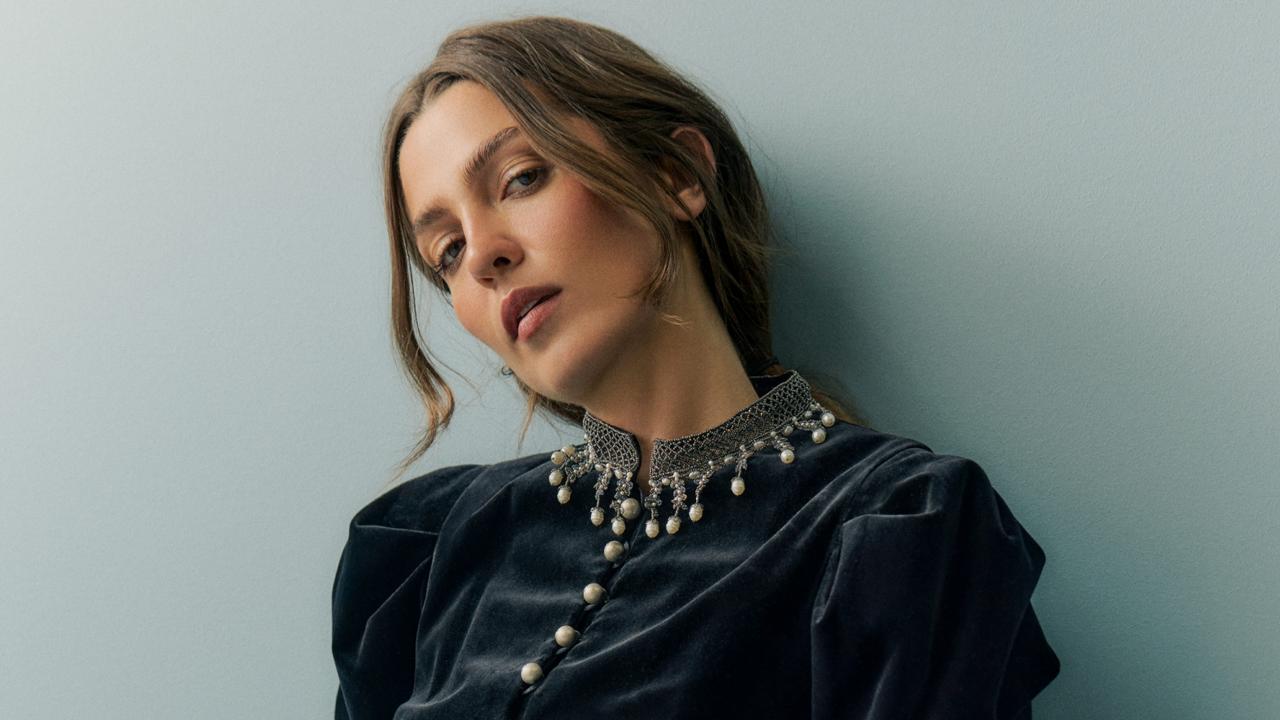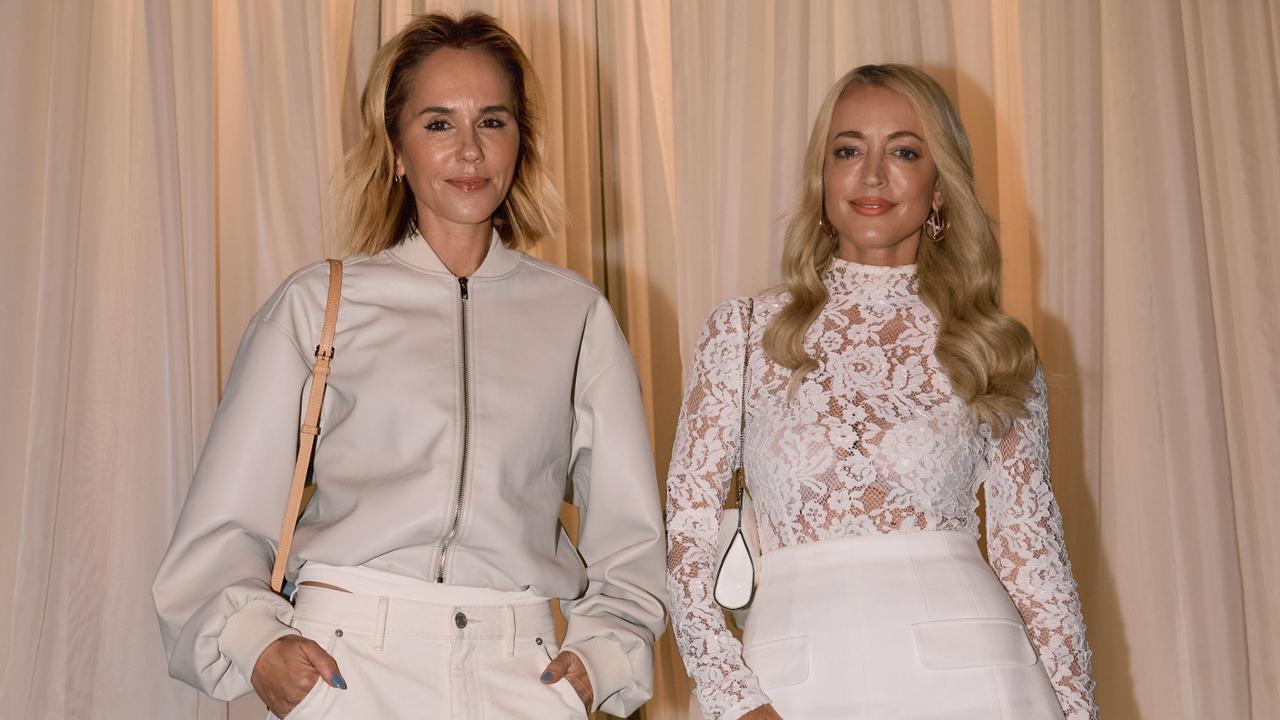Will the AFL Women’s League level the playing field?
THAT the AFL Women’s League will soon kick off is to the credit of those who ignored the sexist naysayers and believed in the ratings potential of female players.

Stellar
Don't miss out on the headlines from Stellar. Followed categories will be added to My News.
AS AN eight-year-old, Melissa Hickey would pretend she was playing AFL on the MCG in front of a roaring crowd. She’d pull on her Geelong guernsey and head out to her family’s front yard, where she would slot the footy through imaginary goalposts. She would high-five the leaves on trees and imagine she was Gary Ablett Senior. She saw herself as the mercurial Cats star, winning the AFL grand final off her boot after the siren.
“I just wanted to be on the big stage,” recalls Hickey. But while she played AFL with the boys in primary school, there was never a pathway to playing at the very top. For an eight-year-old girl, it was a sporting dream she could never fulfil.
Until now. The inaugural AFLW competition season is set to begin, with eight teams competing for the coveted first title from February 3 to March 25. Hickey, now aged 32 and a marquee player for the Melbourne Demons, will be in the thick of it — a fact that she still can’t quite believe.
“It really feels like a dream come true,” she says. “You roll up to training at an AFL facility and you are still pinching yourself. You are not sure if it is real. That little eight-year-old girl who dreamt of this moment comes out again. Right now, I feel pure excitement.”
While Hickey aspired to be like Ablett, now little girls at footy clinics and school appearances say they want to be like her.
“That’s the beautiful part of it all,” she continues. “When little girls say, ‘I want to be the captain of the Melbourne footy club,’ or, ‘My goal is to play in the AFL,’ they now have that direct pathway, and that is really powerful.”
It really feels like a dream come true. You are not sure if it’s real
AFL chief executive Gillon McLachlan sees the women’s league growing stronger as time rolls on. In fact, he reveals to Stellar his hopes for every AFL club to have a women’s team — a feat no other sporting code in the world can lay claim to.
“The AFL has historically been reasonably good at making very long-term, generational decisions and putting the investment behind it,” he says.
“If you think generational [goals], I hope every team in the AFL has a men’s and a women’s team. That’s clearly almost too far out for people to fathom, but in the end that’s the aspiration. It might be 25 years away, I don’t know, [but] that’s clearly where we would like to go.
“It would be a first in the world that all of our clubs have men’s and women’s teams playing under the same badge. I don’t know of another league where that applies. If you look at the professional leagues in the US and other countries, men’s and women’s teams are different franchises. We hope that ultimately all our teams have both.”
NOT SO LONG ago, there wasn’t anyone on the AFL Commission who saw a great need to back a women’s league. No one except Sam Mostyn. With a background in government and corporate affairs, she was the first woman appointed to the game’s hierarchy back in 2005 and served as a Commissioner until recently.
In fact, some sitting at the AFL Commission and executive table didn’t view a women’s league as intrinsic to the future of the AFL. “Oh, I have seen my sister play once … that’s enough,” was the sentiment from some in the community, and there was a feeling women were already catered for with the local competitions, AFL 9s and junior Auskick.
“Early on, I just wanted the respect and acknowledgment that girls and women wanted the same opportunities to play footy as boys and men,” says Mostyn.
After taking a seat at the Commission, Mostyn increasingly discovered signs women should be given a greater role. She travelled to remote pockets of Cape York and saw the joy on women’s faces as they played footy. She witnessed the happiness and the sense of belonging other women in a local Perth competition felt. Mostyn saw female footballers psyching themselves up in the rooms before a national competition game — albeit games only being played on local footy ovals dotted around the country.

At every footy oval, in every state and territory of Australia, Mostyn noticed the same thing: the hype, the elation, the passion and the love women have for AFL.
“To not act on behalf of the women and girls who loved this game would have been unconscionable,” says Mostyn. “I took my place at that Commission table very seriously, on behalf of the football community who weren’t being heard, to advocate for them.
“As Linda Dessau and Simone Wilkie joined the Commission, momentum grew with many great women champions around the game, from Western Bulldogs’ VP Susan Alberti to AFL manager Jan Cooper and decorated footballer Debbie Lee. Their relentless commitment helped make this league happen.”
Mostyn would often ask the other AFL Commissioners if they had seen women playing football. She made sure they went to games and talked to women who had just played to show them this game meant an enormous amount to them, too.
McLachlan says the clincher for him was an exhibition game between Melbourne and the Western Bulldogs in August 2015 at Etihad Stadium. After witnessing the standard of football and how engaged the crowd was, he says “it felt right” to cement plans for a women’s-only league, and brought forward the original launch date from 2020 to 2017.
He credits Mostyn, who left the Commission last year and is now on the Sydney Swans board, as the “singular force” in the boardroom. “She was just relentless,” he says. “You need people with that conviction and focus to make change. She was singular in her push for equality in every way on every issue.”
When more than one million people tuned in to watch an exhibition match between the Western Bulldogs and Melbourne live on the Seven Network last September, it again signalled an appetite for the women’s game. The TV ratings greatly exceeded the AFL’s expectations and, outside the finals series, it was the largest overall average audience in Melbourne of any game during 2016.
Last November, the AFL also announced women’s participation levels were on the rise. A 56 per cent increase in female community club teams boosted the total female participation by 19 per cent to 380,000. Likewise, participation across all levels of the game jumped 12.5 per cent to a record 1.4 million — growth credited to the establishment of AFLW.
Mostyn would often ask the other AFL Commissioners if they had seen women playing football
But, of course, this latest development did not come without criticism. There’s been grumbling about women getting hurt and the skill level. Also questions on whether a stronger competition at grassroots level should have been more established before committing to an elite competition. One sports columnist dubbed the competition McLachlan’s “fascinating gamble” — which McLachlan is quick to dismiss. “I don’t see it as a gamble,” he says. “It’s the right thing to do, to provide every opportunity for every girl and woman across Australia who wants to play the game at an elite level.
“In the long-term, it makes business sense as it is a key part of our growth. Bringing new people in, not just as players but parents, coaches, administrators. We think ultimately it is going to impact cultural change across our industry.
“Our community and elite clubs will be better and more rounded. The biggest risk is managing people’s expectations. We will be significantly more advanced in year three than we will in year one.”
For Hickey, the days of kicking the footy by herself are well and truly over. The days of using a teammate’s pool in the middle of winter as an ice bath are also gone. No longer does she have to put off physio appointments until the injury is unbearable. She now has a squad of equally ambitious athletes standing by her side as well as the use of Melbourne Football Club’s first-class facilities.

Hickey is one of the few players to have sponsorship (in her case Adidas), but there’s still some way to go for others. Under a pay deal struck for this season, marquee players will receive a financial package of $27,000 (inclusive of $10,000 for their marketing and ambassadorial roles), the priority players will earn $12,000, and the remaining listed players $8500 for the seven-match (plus Grand Final) season. Some players could even be left out of pocket, with private health insurance not included in the pay package. But salaries are set to improve in future seasons — and no one’s losing hope about the overall success.
Hickey shares the same aspiration for the AFLW as McLachlan and Mostyn. “Having a full season rather than just a short season, that is the ultimate goal,” she says. “My dream for the league is eventually we will be professional athletes as well. That would be amazing for girls to be able to choose playing footy as a career.”
Originally published as Will the AFL Women’s League level the playing field?


